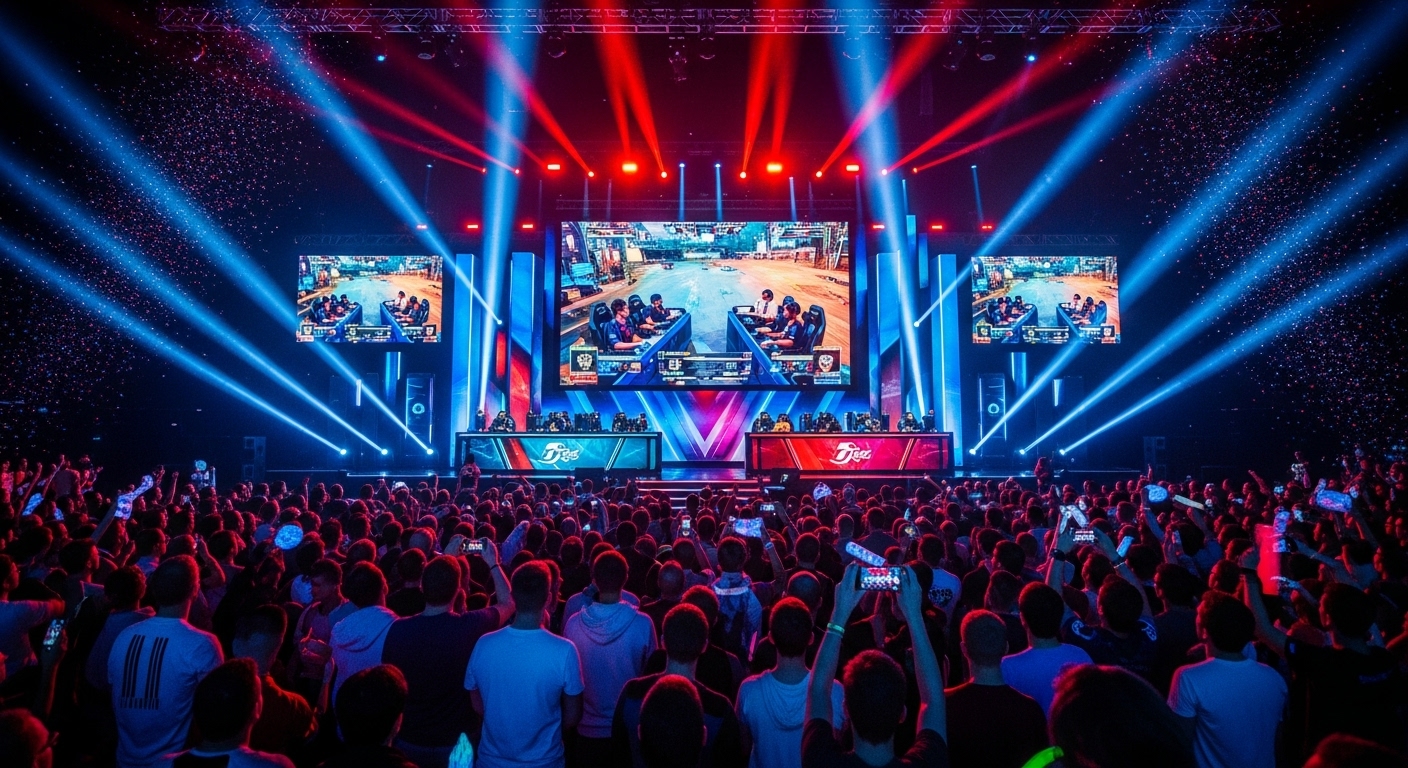Introduction
Esports, once considered a niche form of entertainment, has grown into a global phenomenon with millions of fans and billions of dollars in revenue. Video game competitions have transformed from small gatherings of passionate players into major events filling arenas and drawing audiences that rival traditional sports. One of the biggest reasons for this explosive rise is the power of streaming.
Streaming has not only allowed esports to expand its reach but has also fundamentally shaped the way games are played, watched, and celebrated. Unlike traditional sports that rely heavily on television deals and physical venues, esports thrives in a digital-first environment. Streaming platforms have made it possible for fans to access live tournaments, follow their favorite players, and even participate in building communities that drive engagement.
In this blog, we will explore how streaming has played a central role in the popularity of esports, examining its historical roots, the growth of streaming platforms, the role of influencers and professional gamers, the fan experience, the business side of streaming, and what the future may hold for this thriving industry.
The Early Days of Esports
To understand the role of streaming in esports, it is important to first look back at the early days of competitive gaming. In the 1990s and early 2000s, esports events were mostly small-scale competitions held at local gaming cafes or conventions. While some larger tournaments like the World Cyber Games or Major League Gaming attracted attention, they were primarily limited to niche audiences.
Back then, watching esports was not easy. Fans had to rely on pre-recorded videos, DVDs, or write-ups on websites to learn about tournaments. Without a convenient way to broadcast games live to the world, esports remained largely underground, accessible mostly to those already involved in the gaming community.
Streaming changed everything. With the rise of high-speed internet and platforms that allowed live video broadcasting, esports suddenly became visible to a global audience. This accessibility helped turn gaming competitions into must-watch events, elevating esports to mainstream entertainment.
The Emergence of Streaming Platforms
The 2010s saw a revolution in the way people consumed media, and esports was at the forefront of this transformation. Dedicated streaming platforms provided an outlet for gamers and organizers to broadcast their content to massive audiences in real time. Unlike traditional television, streaming was interactive, global, and available on-demand.
Streaming made it possible for esports to bypass the limitations of mainstream television networks. Instead of competing for limited broadcast slots, tournaments could reach audiences directly online. This democratized the esports scene, giving exposure not just to major tournaments but also to smaller events and individual streamers who built communities around their content.
The availability of streaming platforms coincided with a surge in professional esports organizations, tournaments with multimillion-dollar prize pools, and the rise of gaming celebrities who attracted millions of viewers. Fans no longer needed to wait for highlight reels—they could watch the action unfold live, from anywhere in the world.
Streaming and Accessibility
One of the key factors in the rise of esports popularity is accessibility. Traditional sports often require expensive broadcasting rights, subscriptions, or geographical proximity to stadiums. In contrast, esports content is widely available and often free to watch online.
Streaming platforms provide access to global events without barriers, enabling fans in different countries to watch tournaments in real time. This accessibility has contributed to the diversity of the esports audience, drawing viewers from across continents, age groups, and cultures.
Furthermore, the ability to stream from multiple devices—computers, smartphones, tablets, or even smart TVs—has ensured that fans can stay connected wherever they are. This level of convenience has made esports not just a form of entertainment but a lifestyle for many enthusiasts.
The Role of Professional Players and Influencers
Streaming has also given rise to a new kind of celebrity: the esports influencer. Professional players and popular streamers often broadcast their practice sessions, interact with fans, and provide behind-the-scenes looks into their lives. This level of accessibility to the personalities behind the games has helped create deeper connections between players and audiences.
Unlike traditional athletes who are often distant from their fans, esports players use streaming to engage directly. Fans can chat with them live, ask questions, and feel a sense of personal connection. This interaction fosters loyalty and drives the growth of dedicated fan bases.
Influencers and streamers also serve as entry points for new audiences. Even those who may not follow competitive esports closely can still be drawn in by entertaining personalities, creative gameplay, or collaborative events hosted by popular streamers. As a result, the lines between esports competition and gaming entertainment have blurred, with streaming acting as the bridge that unites both worlds.
Community Building Through Streaming
One of the most powerful aspects of streaming is the community element. Live chats, fan forums, and interactive features turn watching esports into a social experience. Fans are not just passive viewers; they become active participants in the discussion, cheering, debating, and celebrating victories together.
Streaming platforms foster global communities where people from different cultures can share their passion for gaming. For many, being part of an esports community is about more than just watching matches—it is about belonging to a group that shares the same excitement, interests, and goals.
This sense of community is further amplified by fan-driven content such as memes, highlights, commentary, and analysis, all of which circulate rapidly online. Streaming acts as the central hub for these activities, keeping fans connected long after a tournament ends.
The Business of Esports Streaming
The popularity of esports streaming has also created significant business opportunities. Advertising, sponsorships, and partnerships thrive on the high engagement rates that esports content generates. Streaming platforms often serve as digital arenas where brands can connect with younger audiences in authentic ways.
Esports tournaments streamed online attract millions of viewers, making them valuable platforms for advertisers. Major companies sponsor teams, events, and streamers, seeing them as gateways to tech-savvy audiences that are otherwise hard to reach through traditional media.
Additionally, streaming platforms themselves benefit financially through subscriptions, donations, and virtual gifting systems where fans support their favorite streamers directly. This has created sustainable revenue models for both platforms and content creators, ensuring that esports continues to grow as a professional industry.
The Impact on Traditional Media
The rise of streaming in esports has also challenged traditional media. Television networks that once ignored gaming have been forced to pay attention as esports audiences rival those of major sporting events. Some broadcasters have even attempted to partner with esports organizations or acquire broadcasting rights for major tournaments.
However, esports remains primarily a digital-first experience. Unlike traditional sports, which built their foundations on television, esports grew up on streaming. This has allowed it to adapt quickly to new technologies, shifting viewer preferences, and interactive media experiences.
Traditional broadcasters may never fully dominate esports coverage because streaming provides a level of flexibility and engagement that television struggles to replicate. The interactivity, global accessibility, and constant flow of content make streaming the ideal medium for esports consumption.
Streaming Technology and Innovation
The evolution of streaming technology has also played a vital role in the success of esports. High-definition video, minimal delays, and improved internet infrastructure have made it possible to broadcast complex, fast-paced games smoothly. Innovations such as multi-angle viewing, instant replays, and integration with statistics have enhanced the fan experience.
Moreover, streaming platforms often experiment with new features to keep audiences engaged. Live polls, chat-based interactions, and interactive overlays provide unique ways for fans to immerse themselves in the action. This constant innovation has ensured that esports streaming remains exciting and engaging.
The use of AI-driven recommendations has also helped fans discover new games, tournaments, or streamers that match their interests. This personalized approach keeps audiences coming back, expanding the overall popularity of esports content.
Esports Events and Global Reach
Streaming has transformed esports tournaments into global spectacles. Events like international championships can attract millions of concurrent viewers online, often surpassing the audiences of traditional sports finals. The ability to watch these tournaments live, regardless of location, has broken down geographical barriers.
Major events are often streamed in multiple languages, ensuring that fans across the world feel included. This global reach has not only increased the popularity of esports but has also created opportunities for cross-cultural exchange within the gaming community.
For many fans, attending a live event may not be possible due to distance or cost. Streaming provides the next best thing, allowing viewers to experience the thrill of esports in real time, complete with commentary, fan reactions, and professional production quality.
Challenges of Esports Streaming
While streaming has undoubtedly fueled the rise of esports, it also comes with challenges. One of the biggest issues is platform dependency. Esports organizations rely heavily on specific platforms, which means changes in policies or monetization strategies can impact creators and tournaments significantly.
Piracy and illegal streaming also remain concerns, as unauthorized broadcasts can siphon off viewership and revenue. Ensuring that official streams remain the primary source for audiences requires constant vigilance and technical safeguards.
Additionally, the sheer volume of content available can sometimes overwhelm audiences. With so many tournaments, leagues, and individual streamers broadcasting daily, fans may struggle to keep up, leading to fragmentation in viewership.
The Future of Esports Streaming
Looking ahead, streaming will continue to be at the heart of esports growth. With advancements in technology such as virtual reality, augmented reality, and ultra-low latency streaming, the fan experience is set to become even more immersive.
Esports may soon integrate features that allow fans to virtually step into the game, choose player perspectives, or even interact with tournaments in real time. These innovations will push esports further into the mainstream, setting it apart from traditional sports experiences.
Moreover, the continued rise of mobile streaming and cloud gaming will ensure that esports remains accessible to audiences worldwide. As internet infrastructure improves globally, more people will be able to participate in esports communities, either as players, viewers, or content creators.
The role of streaming in building careers will also expand. Many young gamers now see streaming as a viable path to becoming professional esports players or gaming influencers. This cycle of community-driven growth ensures that esports will continue to thrive for years to come.
Conclusion
The rise of esports as a global entertainment powerhouse cannot be understood without recognizing the transformative role of streaming. From making competitions accessible to worldwide audiences to creating opportunities for players, fans, and businesses, streaming has become the lifeblood of the esports industry.
Streaming has not only made esports popular but has also redefined how people interact with entertainment. It has created new forms of celebrity, built global communities, and challenged traditional media’s dominance. While challenges remain, the synergy between esports and streaming continues to drive innovation, accessibility, and growth.
As technology evolves and fan engagement deepens, streaming will remain the foundation of esports popularity. The journey from niche competitions to mainstream dominance is still ongoing, but one thing is clear: streaming has turned esports into more than just a competition—it has made it a worldwide cultural movement.



